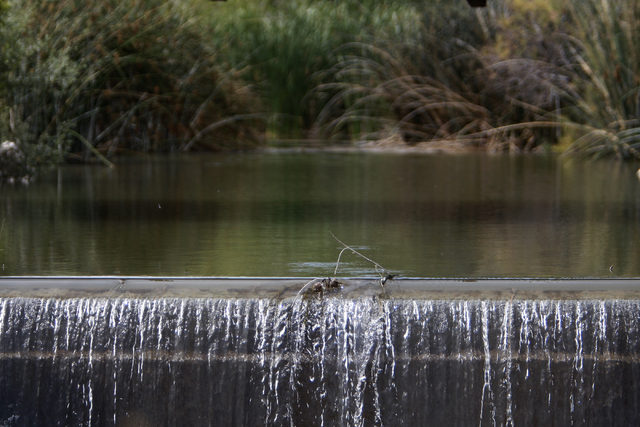Return flows deserve all credit for Las Vegas’ water supply

On one hand, taking extra-long showers or letting the water run down the sink while you brush your teeth are bad habits that all desert dwellers really ought to break.
On the other hand, none of that really matters when it comes to saving water in the Las Vegas Valley.
That’s because virtually every drop of water washed down a drain or flushed down a toilet in this valley ends up being recycled under an all-important arrangement unlike any enjoyed by a major city served by the Colorado River.
It’s called a return-flow credit. Simply put, it’s the reason we’re all here right now.
More than any pipeline or pump station, two key factors have kept the community supplied with water despite its tremendous growth: Proximity to Lake Mead and the ability to reuse the wastewater it cleans and returns to the lake.
It works like this: The Southern Nevada Water Authority can pump as much water as it likes out of Lake Mead, as long as enough is returned to the reservoir to keep the total net use at or below the state’s annual allotment from the lake.
“It’s not a new concept at all. It’s typical of water rights anywhere in the West: Your diversion minus what you return to the river equals your consumptive use,” said Jayne Harkins, executive director of the Colorado River Commission of Nevada. “But it’s absolutely been a huge benefit for us. You want to keep reusing as much as you can.”
Without the return-flow credit, the valley would have outgrown Nevada’s supply of Colorado River water in 1992. That was the first year the community pulled more water from Lake Mead than the state’s annual allotment of 300,000 acre-feet.
One acre-foot of water is enough to supply two average Las Vegas homes for just over a year. The Southern Nevada Water Authority pumps about 440,000 acre-feet from the lake each year, but the community of 2 million residents and 40 million annual visitors actually consumes an average of about 227,000 acre-feet. That’s all thanks to return-flow credits.
The arrangement has been around since in the 1920s, when the river was first divvied up among the states through which it flows, Harkins said. “The (Colorado River) Compact is based on a consumptive use number, not a diversion number.”
Nevada didn’t really start benefiting until 1971, when the first Lake Mead water was delivered to Las Vegas through pipes, pumps and a new treatment facility built by the U.S. Bureau of Reclamation. Before that, the community lived on groundwater, which it pumped from wells with such abandon that the land began to crack and subside in some areas.
Harkins’ agency submits detailed monthly reports on the state’s diversion from and returns to the Colorado River system to the federal river masters at the Bureau of Reclamation for annual accounting.
It’s no simple equation, either. Exactly how much in credits the valley gets is determined using the U.S. Geological Survey’s stream-flow gauges on the Las Vegas Wash, water delivery information from utilities, and estimates of how much water flowing into Lake Mead comes from natural storm events or from groundwater pumped, used and released downstream. There is even a formula to determine how much water should be subtracted because plants along the wash use it before it can reach the lake.
“They go to that level of detail. It’s pretty amazing,” Harkins said.
The Las Vegas Valley gets 90 percent of its water supply from the Colorado by way of Lake Mead, so return-flow credits have never been more important. And since almost all indoor water — the stuff we use in our sinks, toilets, showers, washing machines and dishwashers — ends up back in the lake by way of wastewater treatment plants that empty into the Las Vegas Wash, the water authority hasn’t done much on household water conservation. Instead, the authority’s conservation efforts focus on lawns, swimming pools and other thirsty features that return little to no water to the lake.
But wasting water indoors is not a completely victimless crime. The more water we use, the more has to be pumped uphill from Lake Mead, disinfected and delivered across the valley. That uses both power and chemicals, both of which carry environmental costs.
If that’s not enough to persuade you to mind the tap, try this on for size: You get billed for every gallon of water you use, regardless of whether it goes on your garden or down your drain and back to the lake.
So think about shutting off the water while you brush. It’ll save you some money.
Contact Henry Brean at hbrean@reviewjournal.com or 702-383-0350. Find him on Twitter: @RefriedBrean